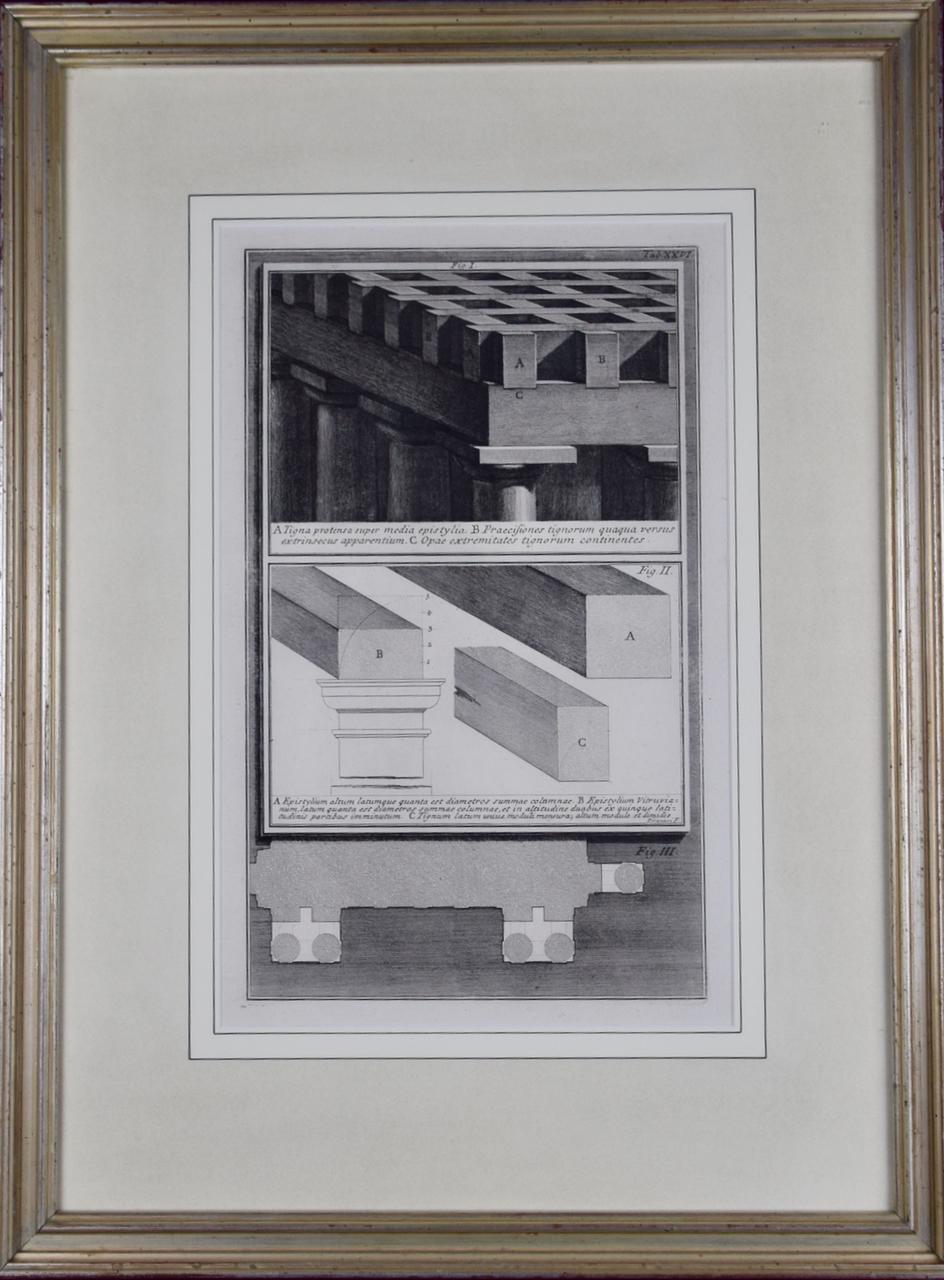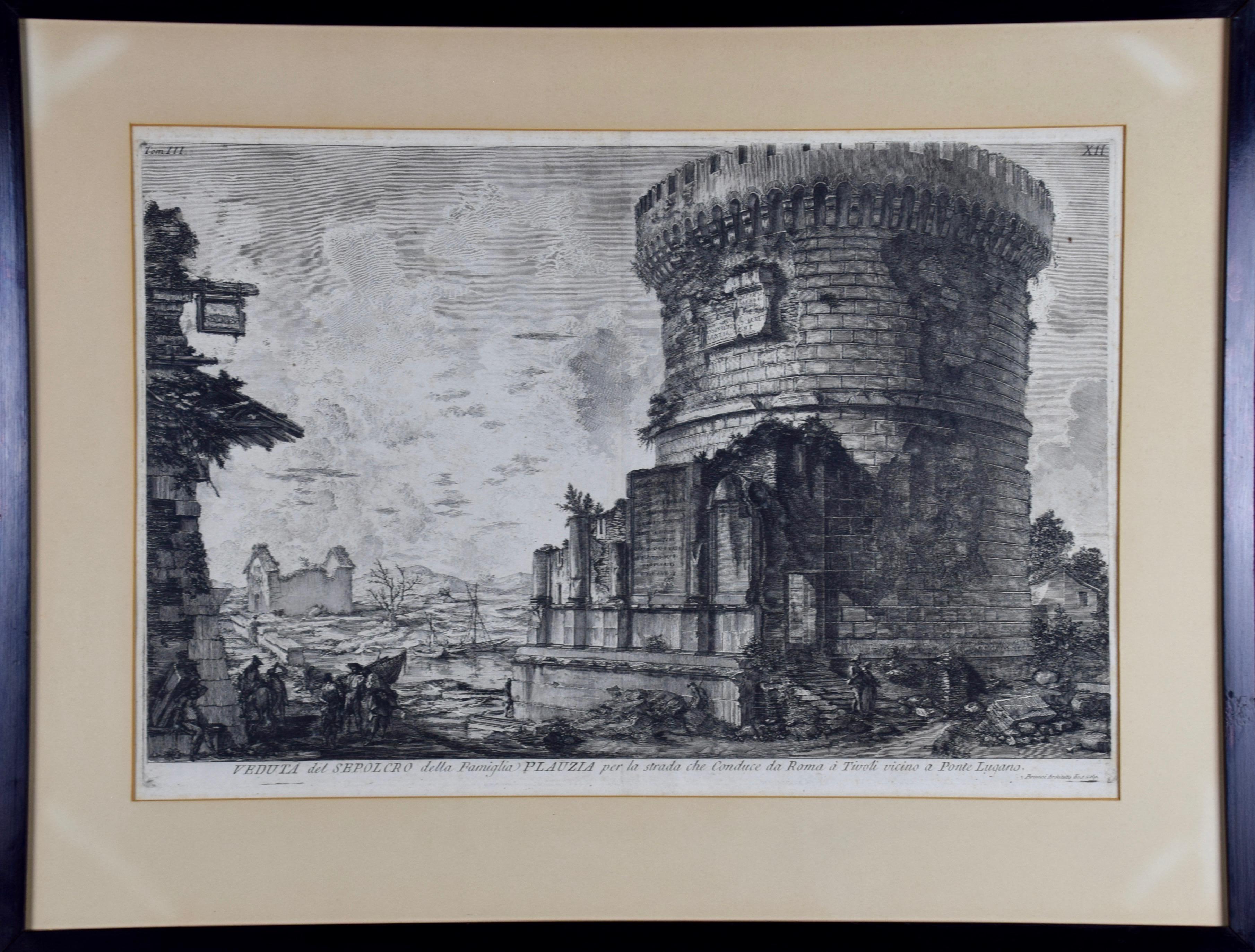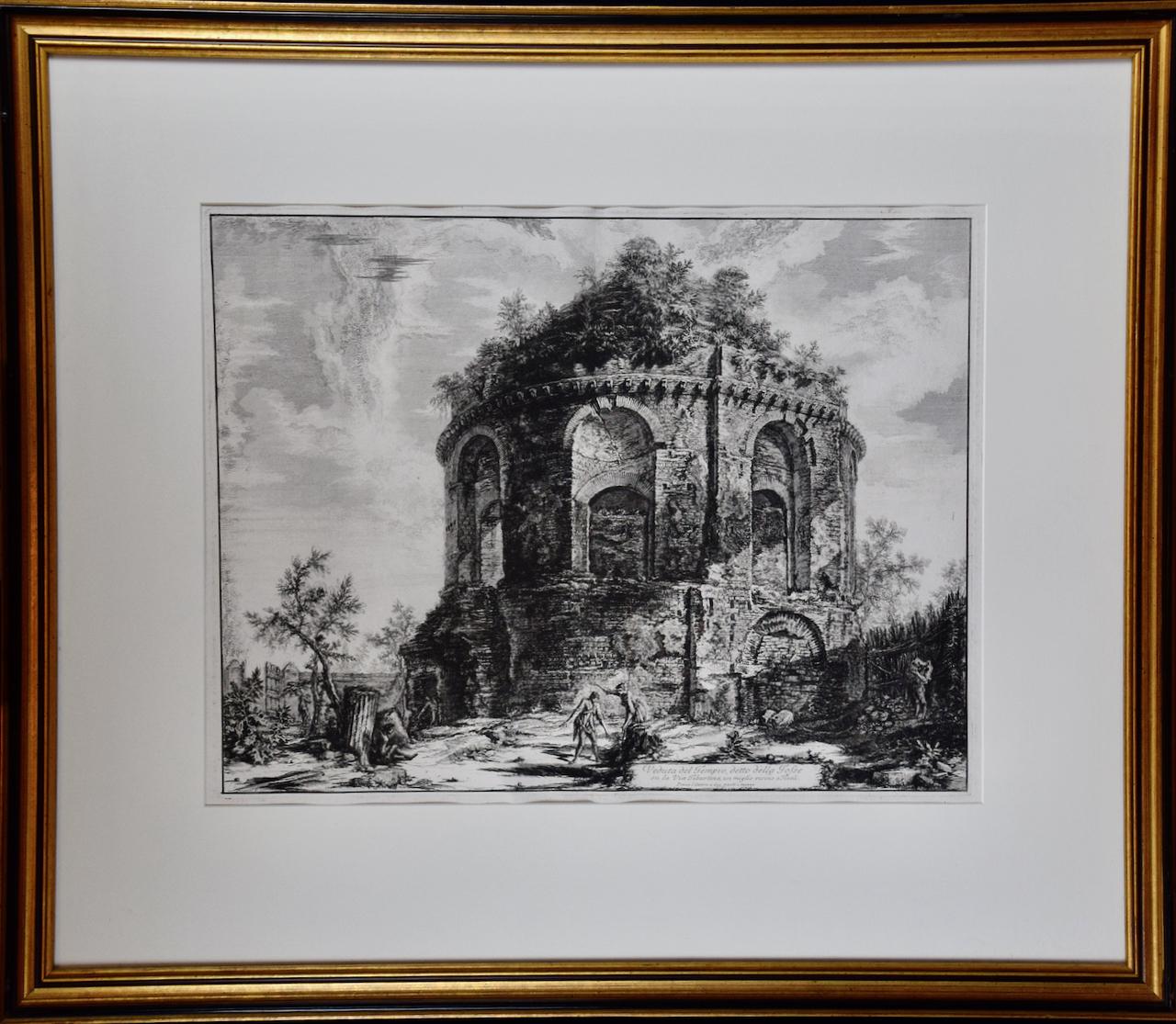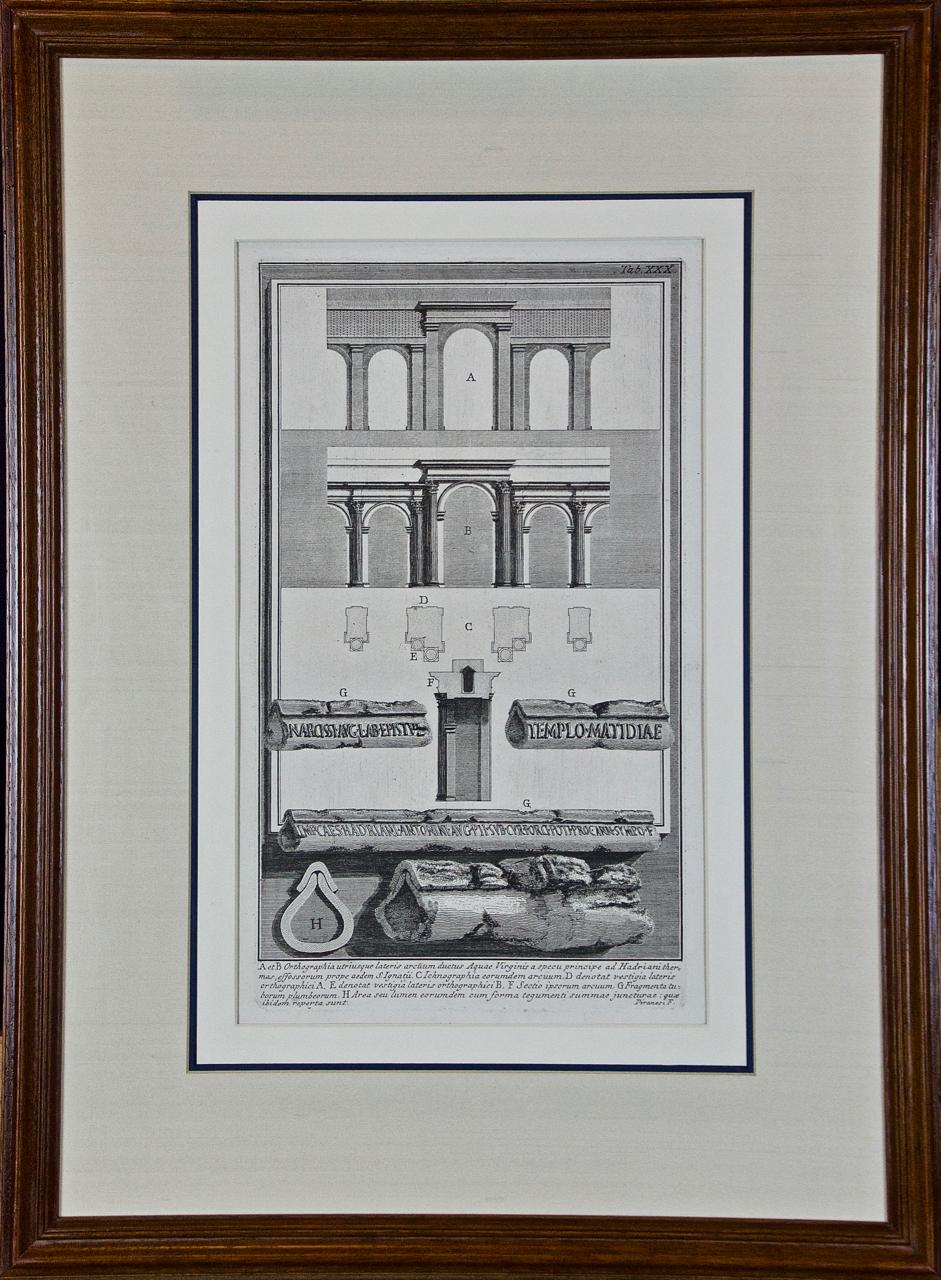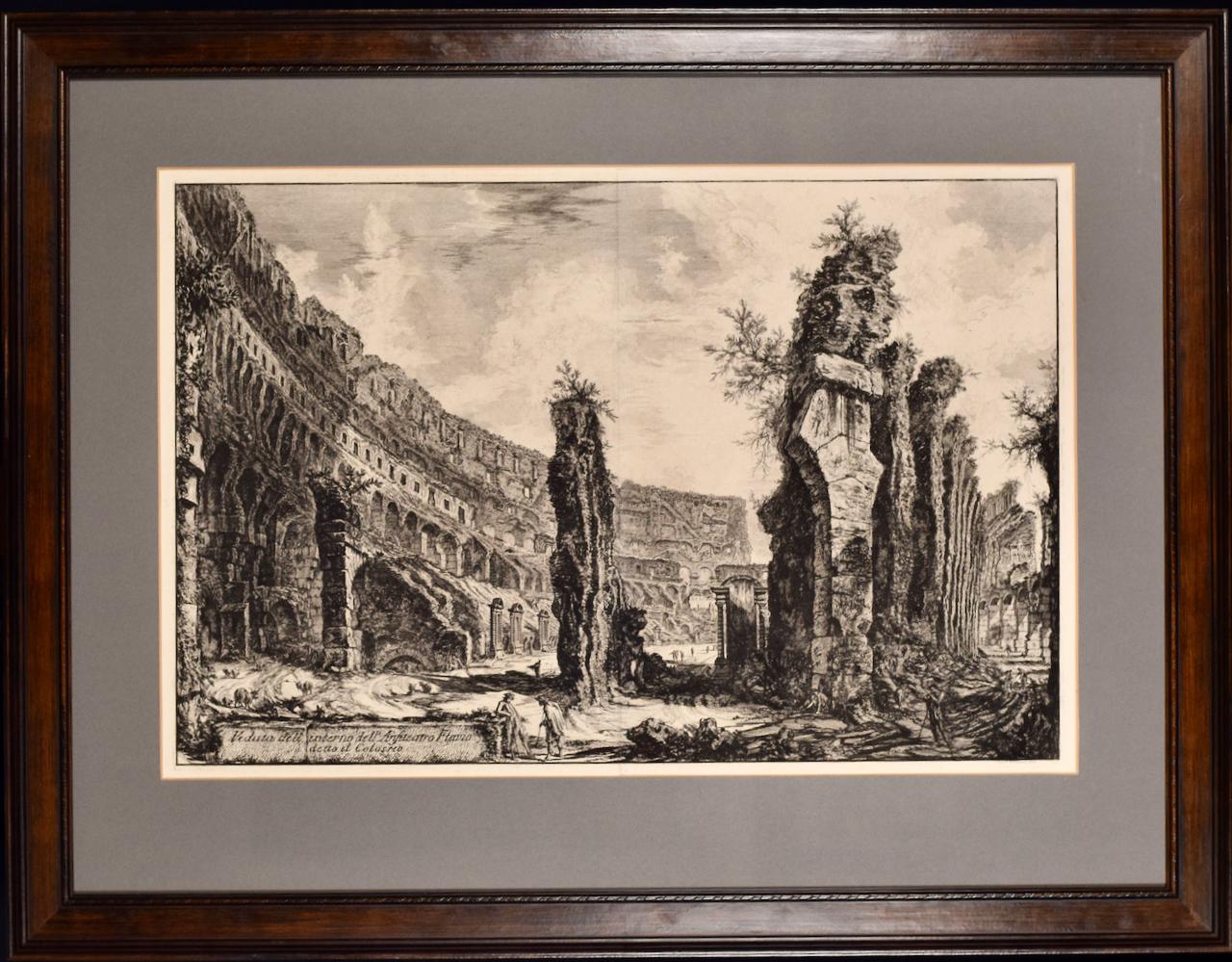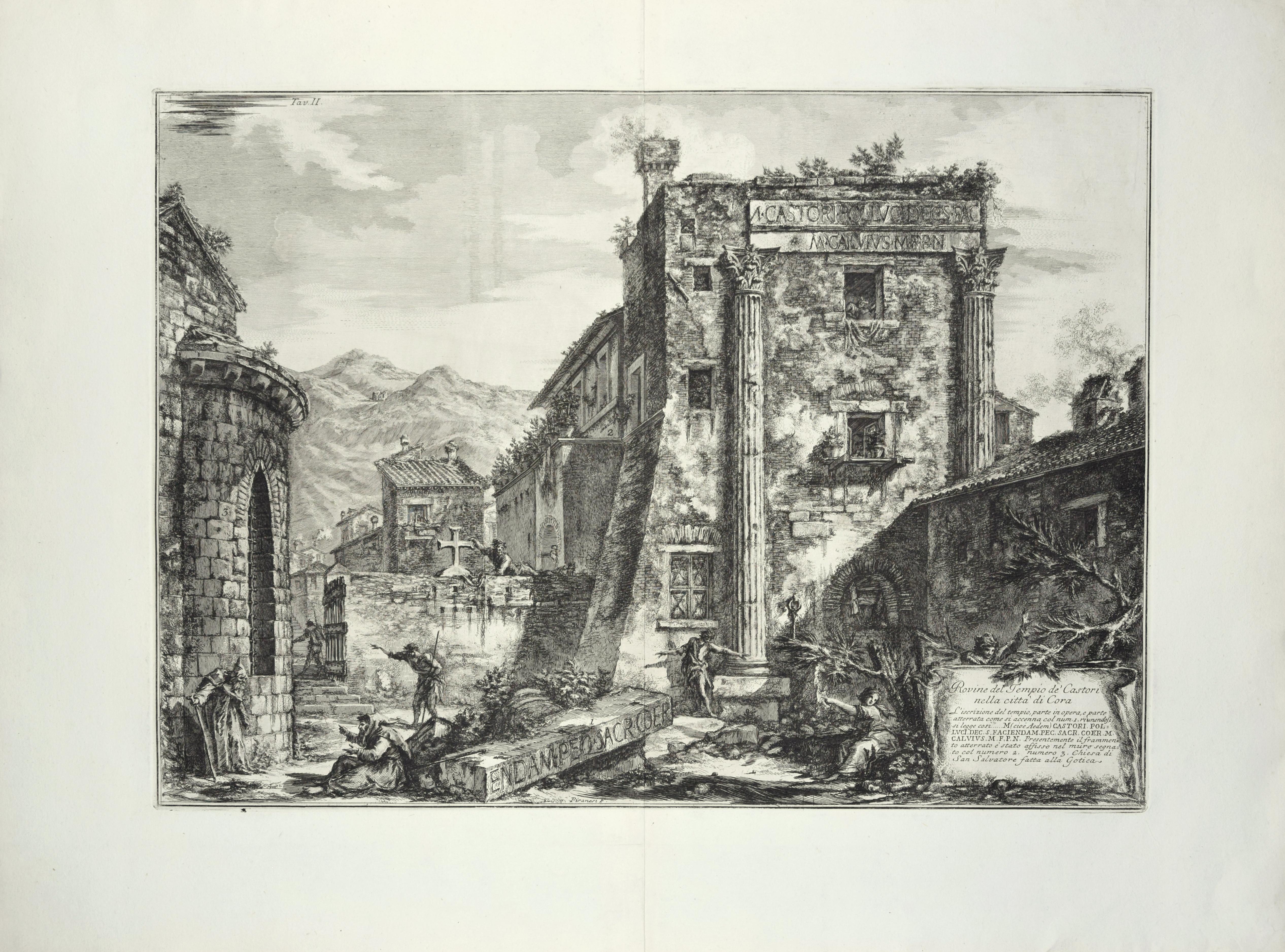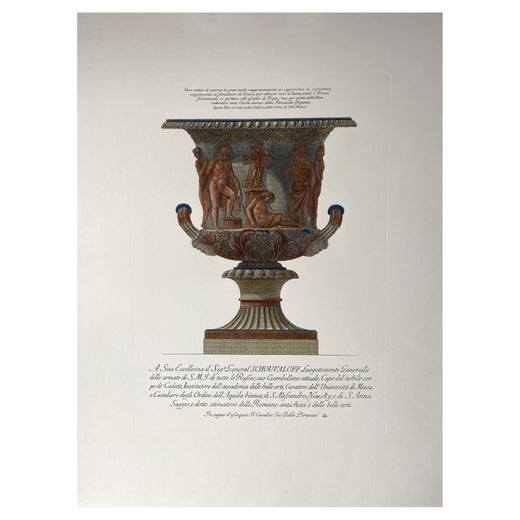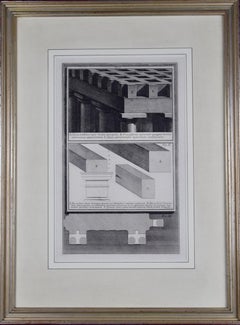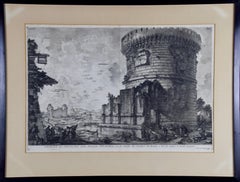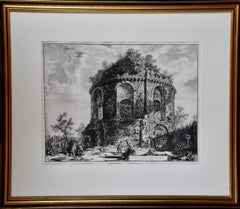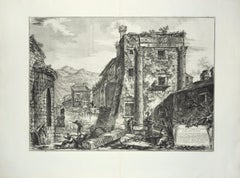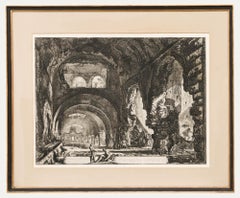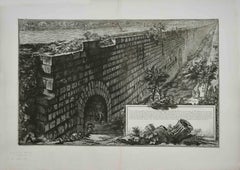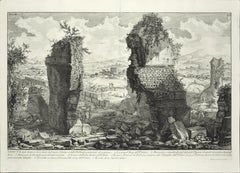Items Similar to Piranesi 18th C. Etching "Reliquiae Theartri Pompejani" an Ancient Roman Theater
Want more images or videos?
Request additional images or videos from the seller
1 of 9
Giovanni Battista PiranesiPiranesi 18th C. Etching "Reliquiae Theartri Pompejani" an Ancient Roman Theater1762
1762
$1,875
£1,418.97
€1,629.76
CA$2,666.34
A$2,890.86
CHF 1,523.48
MX$35,155.71
NOK 18,954.49
SEK 17,924.59
DKK 12,167.09
About the Item
This a framed Giovanni Battista Piranesi (1720-1778) etching entitled "Reliquiae Theartri Pompejani" (Remains of the Theatre of Pompey) from "Il Campo Marzio dell'Antica Roma" (The Campus Martius of Ancient Rome), published in Rome in 1762. It depicts the remains of an ancient theater in Rome with exposed seating and an arch still standing in the foreground. An inset shows an architectural side view of a portion of the structure.
The etching is presented in an antiqued silver-colored wood frame with a cream-colored French mat. The frame measures 24" x 20.75" x 1.25". The print is in excellent condition.
The Theatre of Pompey (Latin: Theatrum Pompeii, Italian: Teatro di Pompeo) was a structure in Ancient Rome built during the latter part of the Roman Republican era by Pompey the Great (Gnaeus Pompeius Magnus). Completed in 55 BC, it was the first permanent theater to be built in Rome. The theater was inspired by Pompey's visit in 62 BC to a Greek theatre in Mytilene.
Giovanni Battista Piranesi (1720–1778) was born in Venice in 1720 and died in Rome in 1778. He was the son of a stone mason and was trained as an architect. After a slow start to his career, he eventually achieved great success as an architect, archaeologist, artist, designer, collector, and antiquities dealer. His mission was to glorify the architecture of ancient Rome through his etchings. He began collecting, restoring and selling ancient architectural objects in the 1760's in partnership with Thomas Jenkins and Gavin Hamilton, who had financed numerous excavations in the Pantanello area of Hadrian’s Villa at Tivoli. In 1768 Piranesi began creating etchings depicting these objects. The plates were eventually published together as a set in 1778 in "Vasi, Candelabri, Cippi, Sarcofagi, Tripodi, Lucerne ed Ornamenti Antichi". Piranesi dedicated many of the plates to patrons, colleagues, good customers and influential people. Many of the antiquities shown in Vasi were eventually sold to King Gustav III of Sweden by Piranesi's son, Francesco Piranesi, after his father’s death, and now reside in the National Museum in Stockholm.
Piranesi's etchings were highly detailed and captured the grandeur of Rome's ancient ruins and architectural marvels. He used a combination of realism and imagination to create dramatic compositions that were both accurate and awe-inspiring. His highly dramatized prints often depict imaginary interiors and frequently include figures in mysterious activities, who are dwarfed by the magnitude of their monumental surroundings.
In addition to his art, Piranesi also designed buildings and interiors in Rome, including the Church of Santa Maria del Priorato and the Villa Adriana in Tivoli. He also wrote several books on archaeology and ancient art. He was also a collector of ancient architectural objects, restoring and often selling them to European tourists. Piranesi was knighted by the Pope in 1765 and he was elected a Fellow of the Society of Antiquaries in England in 1757. Piranesi's style greatly influenced the development of neoclassical art movement of the late 18th century and early 19th centuries. His dramatic scenes inspired generations of set designers, as well as artists, architects and writers. Piranesi died on November 9, 1778, in Rome, Italy, at the age of 58. He is remembered today as one of the greatest artists and architects of the 18th century, whose work continues to inspire and fascinate people around the world. His prints have continued to increase in value to institutions and collectors.
- Creator:Giovanni Battista Piranesi (1720-1778, Italian)
- Creation Year:1762
- Dimensions:Height: 24 in (60.96 cm)Width: 20.75 in (52.71 cm)Depth: 1.25 in (3.18 cm)
- Medium:
- Movement & Style:
- Period:
- Condition:
- Gallery Location:Alamo, CA
- Reference Number:Seller: # 31301stDibs: LU117326054212
Giovanni Battista Piranesi
Piranesi was born in Venice in 1720 and died in Rome in 1778. He was the son of a stone mason and was trained as an architect. After a slow start he eventually achieved great success as an architect, archaeologist, artist, designer, collector, and antiquities dealer. His mission was to glorify the architecture of ancient Rome through his engravings and etchings. His highly dramatized prints often depict imaginary interiors and frequently include figures in mysterious activities, who are dwarfed by the magnitude of their monumental surroundings. Piranesi's style greatly influenced the neoclassical art movement of the late 18th century. His dramatic scenes inspired generations of set designers, as well as artists, architects and writers. His prints have continued to increase in value to institutions and collectors.
About the Seller
5.0
Platinum Seller
Premium sellers with a 4.7+ rating and 24-hour response times
Established in 2011
1stDibs seller since 2019
293 sales on 1stDibs
Typical response time: 1 hour
- ShippingRetrieving quote...Shipping from: Alamo, CA
- Return Policy
Authenticity Guarantee
In the unlikely event there’s an issue with an item’s authenticity, contact us within 1 year for a full refund. DetailsMoney-Back Guarantee
If your item is not as described, is damaged in transit, or does not arrive, contact us within 7 days for a full refund. Details24-Hour Cancellation
You have a 24-hour grace period in which to reconsider your purchase, with no questions asked.Vetted Professional Sellers
Our world-class sellers must adhere to strict standards for service and quality, maintaining the integrity of our listings.Price-Match Guarantee
If you find that a seller listed the same item for a lower price elsewhere, we’ll match it.Trusted Global Delivery
Our best-in-class carrier network provides specialized shipping options worldwide, including custom delivery.More From This Seller
View All18th Century Etching of Ancient Roman Architectural Objects by Giovanni Piranesi
By Giovanni Battista Piranesi
Located in Alamo, CA
A. Tigna Protensa Super Media Epistylia, B. Praecisiones Tigorum Quaqua Versus Extrinsectus Apparentium, C. Opae Extremitates Tigorum Contintes, Fig. I, plate 88 from "Vasi, Candelab...
Category
Mid-18th Century Old Masters Figurative Prints
Materials
Etching
Ancient Roman Architecture: Original Framed 18th C. Etching by G. Piranesi
By Giovanni Battista Piranesi
Located in Alamo, CA
"Veduta del Sepolcro della Famiglia Plauzia per la Strada Che Conduce da Roma a Tivoli vicino a Ponte Lugano" from "Le Antichità Romane" (Roman Antiquities), one of the most famous works by Piranesi. "Antichita" illustrates the tombs along the Appian Way...
Category
Early 18th Century Old Masters Figurative Prints
Materials
Etching, Engraving, Drypoint
Ancient Roman Temple Architecture: An 18th Century Framed Etching by Piranesi
By Giovanni Battista Piranesi
Located in Alamo, CA
This is an 18th century etching by Giovanni Battista Piranesi entitled "Veduta del Tempio detto della Tosse su la Via Tiburtina, un miglio vicino a Tivoli" (View of the so-called Tem...
Category
1760s Old Masters Figurative Prints
Materials
Etching
Piranesi Etching of Hadrian's Ancient Roman Aqueduct and Baths, "Aquae Virginis"
By Giovanni Battista Piranesi
Located in Alamo, CA
This is a framed Giovanni Battista Piranesi (1720-1778) etching entitled "Orthographia utriusque lateris arcuum ductus Aquae Virginis a specu principe ad Hadriani thermas, effossorum...
Category
Mid-18th Century Old Masters Landscape Prints
Materials
Etching
The Roman Colosseum: A Framed 18th Century Etching of the Interior by Piranesi
By Giovanni Battista Piranesi
Located in Alamo, CA
This large framed 18th century etching by Giovanni Battista Piranesi entitled "Veduta dell'interno dell'Anfiteatro Flavio detto il Colosseo" (View of the interior of the Flavian Amph...
Category
1760s Old Masters Figurative Prints
Materials
Etching
Ancient Roman Architecture: Framed Original 18th C. Etching by G. Piranesi
By Giovanni Battista Piranesi
Located in Alamo, CA
"A sua Eccellenza il Signor Henry Hope Cav. Scozzese Amatore delle Belle Arti from "Vasi, Candelabri, Cippi, Sarcofagi, Tripodi, Lucerne, Ed Ornamenti Antichi", (Vases, candelabra, grave stones, sarcophagi, tripods, lamps, and ancient ornaments) is an etching by Giovanni Battista Piranesi, published in 1778. It depicts stone caryatids...
Category
1770s Old Masters Figurative Prints
Materials
Etching
You May Also Like
Rovine del Tempio de' Castori nella città di Cora - Etching by G. B. Piranesi
By Giovanni Battista Piranesi
Located in Roma, IT
Image dimensions 40.6x56.8.
Belongs to the Collection "Antiquities of Cori, described and etched by Giovambat Piranesi", and printed in 1764.
Beautiful first roman edition/1st state ...
Category
1760s Landscape Prints
Materials
Etching
After Giovanni Battista Piranesi - Early 20th Century Etching, Villa of Maecenas
Located in Corsham, GB
A charming etching depicting Giovanni Battista Piranesi's Villa of Maecenas at Tivoli. Inscribed with artist name in plate. Presented in a black and gilt frame. On paper.
Category
20th Century Landscape Prints
Materials
Etching
Veduta della Magnifica Sostruzione Fabricata - Etching by G. B. Piranesi -1760s
By Giovanni Battista Piranesi
Located in Roma, IT
View of the magnificent substructure is an original etching realized by the italian artist Giovanni Battista Piranesi.
Very precoius and rare specimen. Roman edition.
Complete tit...
Category
Late 18th Century Figurative Prints
Materials
Etching
Veduta degli Avanzi sopra terra dell'antico Ustrino - Etching by G. B. Piranesi
By Giovanni Battista Piranesi
Located in Roma, IT
Image dimensions 40x60.
Veduta degli Avanzi sopra terra dell’antico Ustrino (View of the visible remains of the ancient crematorium) is a wonderful black and white etching on thick...
Category
1750s Landscape Prints
Materials
Etching
Giovanni Battista Piranesi, 18th C. Engraving, View Of The Ruins
By Giovanni Battista Piranesi
Located in Bridgeport, CT
Italian, 1720-1778. With an expected fold down the middle. View of the "Casa Aurea Nerone". From the "Veduta di Roma" series. Artist name in plate lower right.
Dimensions: sight 17...
Category
Antique 18th Century Italian Renaissance Prints
Materials
Glass, Wood, Paper
Dimostrazioni dell'Emissario del Lago Albano - Original Etching by G.B. Piranesi
By Giovanni Battista Piranesi
Located in Roma, IT
G.B. Piranesi, Dimostrazioni dell’Emissario del Lago Albano, Illustrations of the Emissarium of Lake Albano
Etching, Drypoint, Burin on laid paper. Signed on...
Category
18th Century Landscape Prints
Materials
Drypoint
